The last post about the Hallberg Rasssy 50 raised a lot of interest (+ 5000 hits in two days) but many comments in the forums about the HR50 show that many have a biased view about its design program. Many see it as a boat designed to be ideally suited to voyage and to circumnavigate, but, while being able to do that, the boat program is much more generic, in fact, it is a main market yacht, like Oceanis or a C50 Bavaria.
That does not mean that the yacht cannot be used on a different program with some modifications and some additional equipment, namely a circumnavigation, it means only that it was not its main design criteria and does not come standard prepared to do that.
On a main market yacht the aim is to provide a simple and easy-to-sail yacht, even for the ones that are not very experienced sailors and want to cruise, using sailing as an inexpensive means to do that. They want a reasonable performance under sails and a good performance while motoring.
Voyage boat, as a denomination for a type of yacht and boat program, is not yet much used in English. The term bluewater boat is much more common, but it is a much more imprecise term because it does not refer to the yacht's main use, but to the ability to sail bluewater, and in what it regards many main market boats are bluewater boats, including obviously the HR50 (and the Bavaria C50).
Cruising boats' interiors are designed taking into consideration these two different and many times conflicting criteria: what is perfect to live on the boat while sailing and what is perfect to live at an anchorage or marina. Generally, a cruising boat interior reflects a compromise between these two contradictory needs, with main market boats having it more to one side and voyage boats, more to the other.
They are main market yachts, not because they are better or worse than any other type but because they are the ones that better suit the needs of the majority of cruisers and sailors, that prefer to sail in hot climates, during the sailing season, doing day sailing and stopping at night at an anchorage or marina, sometimes passing several days there.
The Pegasus 50 is a voyage boat but even in what regards these, there are two different sub-types, a main one, nowadays mostly aluminum yachts, like Boreal, OVNI, Allures or Garcia and a smaller subgroup of performance voyage boats like JPK (C), Pogo, RM, Cigale and several other semi-custom yachts like the FC53, the JP54.
The overall balanced performance makes it more adapted than the others to coastal sailing conditions, including Med and Baltic sailing, even if to a better performance upwind corresponds also sailing with more heel. To counteract that inconvenience, they propose a gimballed saloon table and seats that can be turned into a berth, ideally suited to sleep while on passage.
http://interestingsailboats.blogspot.com/2020/03/a-true-bluewater-cruiser-pegasus-50.html
On the Pegasus 50 they use top-quality building materials and processes. The hull and deck use vacum infusion, vinylester resins on sandwich composites, with fiberglass and a PVC core. On the structural bulkheads and structural parts of hull, they use also vinylester-epoxy-carbon sandwiches having the structure about 50% carbon fibers.
The Pegasus has a 39.7% B/D while the Hallberg Rassy has 35.2%. Furthermore the Pegasus with about the same draft (2.30m to 2.35) has a much more efficient tandem torpedo keel that maximizes B/D. That difference in B/D and keel effectiveness gives Pegaso a better stability curve with a higher AVS (125º to 114º) and with a proportionally bigger force righting the boat up from a knock-down to 90º.
Regarding that weight difference, we will have to consider that part of it is due to bigger HR50 length and beam. The HR is a bigger boat with a 15,2 m HL and14.8m LWL while the Pegasus has 15.0 HL and 14.1 LWL. The HR has 5.0m beam and Pegasus 4.8m. Also, the type of lighter material used on the Pegasus furniture contributes to diminishing the overall boat displacement.
Less weight means not only a faster boat but a smaller sail area for a given wind and the same speed, with all the advantages that brings regarding sail handling. Pegasus has a 135.1m2 upwind sail area, bigger than the standard HR sail area (131.5m2) but smaller than the "optimized" sail area (149.5m2). If the HR 50 is already a lot slower than the Pegasus, who would want the standard sail area? Only the ones that would use the yacht many times as a motor-sailor.
To have a detailed look at the Halberg Rassy 50, with many photos and information look here:
https://interestingsailboats.blogspot.com/2021/03/hallberg-rassy-50-most-beautifull-hr.html
Unfortunately, all tests to date were performed almost without wind and out of a small puff with 8kt, where the Pegasus sailed close to wind speed, no other meaningful data could be registered, except the lack of information given by the steering wheel, due to the hydraulic system.
Note that lack of information does not mean lack of effectiveness, it means that the rudder gives little information regarding the forces that it is subject to. The ones that sailed with a fully hydraulic rudder system know the feeling (or lack of it). Anyway, this is irrelevant while the boat is sailed by autopilot but in what regards hand steering it will take the fun away and will make it less precise.
The Pegasus 50 offers a dedicated interior pilot station, ample storage, a good galley very well adapted to cooking with heeling, two good cabins and an additional space that can be used as an "office" or as a small cabin for two kids or one adult. It has two heads, one small and a bigger one with a separate shower. The interior storage is good and the access to the technical area and engine is very good.
This boat does not offer in-mast furling, not standard not even as an option due to possible jamming problems. As standard, it offers a boom automatic one-line reefing system with a big lazy bag. They have considered a furling boom but they gave it up due to the price of a top carbon system. It is not offered as an option but it can be mounted if a client desires it.
The mainsail control is a single-line system without a traveler mounted on an arch. I would have liked a bigger distance between the two rollers on the arch for a better downwind sailing, but this way upwind, close to the wind, the forces on the arch are smaller and the correct tension on the boom easier to get.
Three different headsails, two of them fixed and a removable code 0 (or gennaker) on the bowsprit allows for a big sailing potential and one that can be managed by a short crew, even solo (medium-skilled sailor), or by a couple. This configuration is possible due to the mast position, that following a similar evolution on racing solo yachts, is much more aft than what it was some years ago.
It is possible to make a functional interior with good design quality. The parts I find particularly disagreeable are the prominence of aluminum in the galley, giving it an industrial kind of look and the prominence of white everywhere, particularly on the lower surfaces and saloon floor. Also the general design treatment of surfaces, for instance, the space between the saloon seats and the upper "windows" is poorly treated, even if not in what regards functionality.
And I am not talking about interior space, which is much bigger on the HR 50 (to the cost of a dinghy garage and lots of storage space) but about the design quality. That has nothing to do with style (that can be different) but with quality in design.
On the Pegasus it would have made more sense to have two good cabins instead of three cabins, but just a good one. Fortunately, that is possible without changes on the bulkheads and even if not proposed in any of the possible layouts, it is easy to rearrange the space gaining in the process a bow locker and allowing for a decent chart table on the inside steering post.
From the different proposed layouts, the one that makes more sense is the one with a huge sail locker at the bow, one good cabin and a small cabin.
This layout would make sense for a couple that wants to circumnavigate or sail extensively but will not provide a comfortable second cabin for guests or for two couples to sail extensively. Of course, if they are children and family there will not be a problem. Better than the second small cabin, the saloon can be easily transformed into a big "bed".
Only the ones that don't pass much time at anchor cannot understand this need and this boat is designed for the ones that like to voyage but those who belong to the group that likes better to be at anchor than in a marina, and even if they sail and voyage a lot, they will be passing at least as much time at anchor as sailing and that makes the absence of a way to visually control the boat position from the main cabin an important flaw.
If there are "windows" on the bow cabin at the right position there is no need to get out of bed and a simple look at the reference points will tell the sailor if all is well. On this yacht, the sailor will have to get up, go out of the main cabin and go to the saloon to be able to watch if everything is alright. Very uncomfortable, potentially dangerous. I would hate to sleep on this boat at anchor and I spend a lot of time at anchor, as do many sailors, even if I sail more than most.
But that will be an excellent berth for sleeping while the boat is sailing, because it can be gimballed to each side 10º (Globe version) allowing for a much more comfortable position when the boat is heeling. That system can also be very useful for having a meal, or just to sit in a more comfortable position while on the way and when for climate reasons it is more comfortable inside than outside.
And probably the saloon can be raised a further step increasing views and diminishing that difference to a single step. The forward view from the salon (without raising it) is only aft and allowed by the big glass surface on the aft part of the cabin that integrates a sliding hatch. In this aspect, it provides even lesser outside views than the saloons that have relatively big windows on the hull.
It has also an interior pilot station with a good view all around that allows sailing the yacht from there with a joystick. It will provide a very comfortable place to steer when it is cold or it rains outside.
A pity for the very reduced space for deploying charts. A secondary inside pilot station is one of those things that is really useful for sailing in colder climates or out of season, even on the med, and that very few boats of this size offer.
This is a very interesting yacht for the ones that want a cruising boat where voyage and all-weather sailing comfort is much more taken into account on the final compromise, than for a main market yacht, with the supplementary advantage to be a fast sailing boat.
Another big advantage is the semi-custom approach, with the possibility of many alterations in what regards finish and interior, allowing you to adapt the boat to your needs and taste, making it your own, and different from all others.
And it is interesting also due to its price, 650 000 euros for the GT version and 850 000 for the Globe version that taking into account the high-quality build materials and processes, it is a reasonable one, lower than any other similar offer with the same equipment or characteristics.
If I would take away the equipment that the Globe has and that I would not be personally interested in having if the boat was for me, I could cut out of the 850 000 euros about 80 000 euros and that would bring the price down to 770 000 euros, even less if I would have instead of the carbon mast an aluminum one with wire rigging (less maintenance). I could use that money for sails and electronics or to make some significant alterations to the interior.
Of course, this is a lot of money but high-quality boats are expensive and boats less suited for living aboard while sailing, much slower, without the possibility of being sailed from the interior, with a not so good safety stability, and without customization possibility, like the Hallberg Rassy 50 or Amel 50 cost respectively, 1,1 million euros and 0.9 million, having as standard much less equipment (all prices without VAT at the shipyard).
Slovenia has been in the last years one of the places where best prices and better quality can be obtained, in what regards sailing boats, and that is probably the reason why they have succeeded. Several quality boats have been produced there, among them Shipman, from where comes some of the expertise used in this yacht.
I have followed their progress, I have discussed several aspects of the boat with them and I can say that I appreciate their honest approach. I have an agreement with them and if any blog follower is interested I can provide free advice (for the sailor) in what regards customization and adaptation of the Pegasus 50 to each one's needs, depending on lifestyle, personal taste, and cruising grounds.
That does not mean that this is the best 50 ft around, not even the best performance voyage boat. Such a thing does not exist and the choice depends on what one wants from a cruising sailboat, the cruising grounds, and personal preference, but this one ticks a lot of cases and it is a sailboat that will keep on sailing when many others will have to use the engine.
I find the interior and layout a bit deceiving, not in the quality of materials, but in what regards design quality. It is a functional interior.... and maybe you like its design and layout a lot more than I do, and if not, due to the semi-custom approach, there is always the possibility of improving many of the things that I find not so well sorted out.



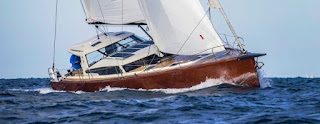









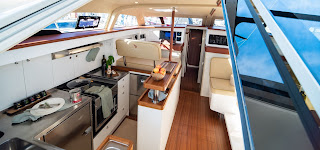




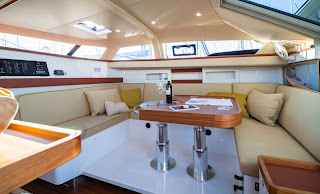
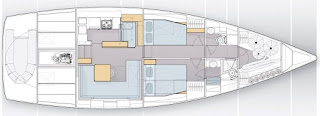

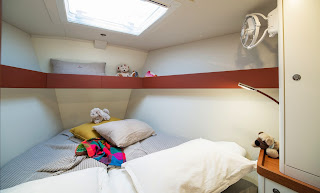


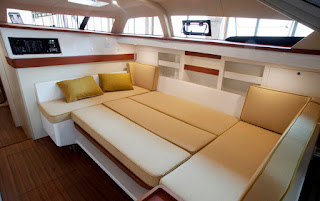




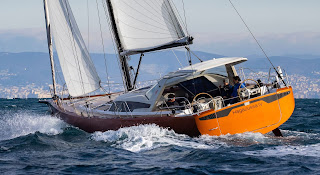
I just love it, and coming from a diehard catamaran sailor, that says a lot. But no view from the cabin whilst at anchor, that's a deal-breaker for me.
ReplyDeleteWhat do you think are the "pros" of this boat compared to your catamaran experience?
DeleteIt is not comparable with condo cats but if the Pegasus is compared with a slightly more expensive performance cat, an Outremer 45, I would say that the Outremer would be faster beam reaching and downwind with medium to medium high winds, the Pegasus 50 faster with light winds and upwind.
DeleteRegarding interior space the Outremer has the advantage of a saloon with an all around view, Pegaso has a much bigger interior storage and also one easier to use.
The Outremer will have the advantage of sailing practically without heel, the Pegaso the advantage of offering more rewarding sailing sensations (for the ones that like them).
Regarding seaworthiness Outremer is a yacht that should be sailed with some care, it is on the safety frontier to what is acceptable (for most) in what regards size for a performance cat. Lighter performance catamarans need to be bigger to have the same seaworthiness and stability of heavier condo cats.
The Pegasus 50 is very far from that frontier, it is a sailboat with a very good overall and safety stability and can be sailed by a duo without prudence concerns meaning that the Pegaso can be sailed much closer to its sailing potential without second thoughts, even while sleeping, when for doing that on the Outremer, I mean sailing close to the yacht sailing potential, a good crew is required, for safety reasons.
That is why we see on the ARC performance cats having a very similar performance to performance monohulls, while both are sailed by a small cruising crew, and you see performance cats having a better performance while raced by a full competent crew.
Personally, if I was interested in doing a circumnavigation, I would have a hard time choosing, for use in the Med or Baltic I would chose the Pegasus (providing I could better the layout and the interior view), but it would be always a very personal choice depending on cruisers and sailors preferences and also budget because a cat will pay almos double in what regards maintenance (two engines) and marinas (beam).
Thank you Paulo, super insightful!
DeleteI've never sailed a large catamaran but indeed, from looking at performance cats being sailed on YT, they seem to be quite a mouthful to handle and not as forgiving as a performance mono would be. Or at least transitioning very quickly from safe to stressing the equipment to breaking something, while on a mono that transition would be more gradual, more evident from the feedback in how the boat behaves and easier to handle.
It's remarkable how this Pegasus 50 bridges a lot of the gaps to a performance cat (livability, speed, comfort), while keeping the advantages that monos have (feeling, upwind performance and all-round ease/forgiveness).
About the layout, how would you arrange it exactly? I couldn't quite grasp it from the article.
That implies work and an article about a boat is not the place to do it, much less exactly (even more work LOL). As I said if someone is interested I can do it without expenses for the client, if he comes to Pegasus through me.
DeleteI believe that in the article I have given enough clues about what I did not like. Regarding layout it passes by the elimination of the third cabin, but instead of having, like they propose, a two cabin layout with the two cabins side by side, having a bigger cabin forward, diminishing the size of the sail locker, that does not need to be as big as they have it (on the two cabin layout).
Fair enough, fair enough :D
DeleteThank you Paulo both for the responses and for the articles!